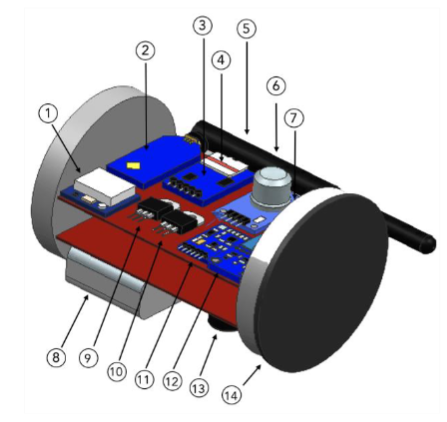CanSat design and implementation for remote sensing applications
DOI:
https://doi.org/10.23917/arstech.v3i2.1188Keywords:
CanSat design , Educational satellite , Microcontroller , Remote sensing , Wireless communicationAbstract
With the increasing potential of satellite technology, it becomes crucial to learn its principles and develop the basic satellite subsystems for the undergraduate level. Working on a real satellite is a challenging target and requires a solid technical background. In contrast, less complex models, such as CanSat, CubSat and HeptaSat, introduce basic ideas to the undergraduate studies level. This paper presents the CanSat design and implementation for remote sensing applications such as measuring the CO2 level in contaminated areas. The CanSat has the size of a soft drink can and simulates the subsystems of the satellite (e.g., payload, power, communication, onboard computer, and structural). Its mission was to be released from a certain altitude and send real-time data to the ground station during landing. The design process was elucidated at the subsystem level. It included the mission requirements and specifications, component selection, and software and hardware design. Arduino Nano was utilised as an onboard computer. A printed Circuit Board (PCB) was designed using Diptrace© to connect the electronic components to Arduino Nano. Xbee was used as a communication module to send the collected data to the host computer. This data was visualised in real-time by LabView©.
Downloads
References
R.J. Twiggs, "Introducing new challenges for future space missions", 2007.
P. Chodkaveekityada, "CanSat design and their applications", in 15th International Conference on Space Operations, Paper ID AIAA 2018-2407, 2018. https://doi.org/10.2514/6.2018-2407.
R. Walker, P. Galeone, H. Page, A. Castro, F. Emma, N. Callens and J. Ventura-Traveset, "ESA hands-on space education project activities for university students: Attracting and training the next generation of space engineers", IEEE EDUCON 2010 Conference, p.p. 1699–1708, 2010. https://doi.org/10.1109/EDUCON.2010.5492406.
N. Sako, Y. Tsuda, S. Ota, T. Eishima, T. Yamamoto, I. Ikeda, H. Ii, H. Yamamoto, H. Tanaka, A. Tanaka and S. Nakasuka, "Cansat Suborbital Launch Experiment-University Educational Space Program Using Can Sized Pico-satellite", Acta Astronautica, Vol. 48, pp. 767-776, 2001. https://doi.org/10.1016/S0094-5765(01)00039-X.
M. Celebi, S. Ay, M.K. Ibrahim, M.E. Aydemir, M. Bensaada, L. Fernando, H. Akiyama and S. Yamaura, "Design and Navigation Control of an Advanced Level CANSAT", Proocedings of the 5th International Conference on Recent Advances in Space Technologies (RAST), pp. 752-757, 2011. http://dx.doi.org/10.1109/RAST.2011.5966942.
M.E. Umit, W. Cabanas, M. Tetlow, H. Akiyama, S. Yamaura and S. Olaleye, "Development of a Fly-back CANSAT in 3 Weeks", Proceedings of the 5th Conference on Recent Advances in Space Technologies (RAST), pp. 894-807, 2011. https://doi.org/10.1109/RAST.2011.5966953.
J.C. LaCombe, E.L. Wang, M. Nicolescu, P. Rivera, and B. Poe, "Design experiences with a student satellite program", 2007.
M.S. Johari, N.N. Bakar, M.N.F.M. Anuar, M.S.Z. Kamal, N.A.A. Shah, C. Lijun, K.H.K. Bahrin, H.A. Shafie, M.N.A. Sulong, and M. Okasha, "Design and Realisation of a Nanosatellite for Malaysia SiswaSAT Competition 2020", in 2020 IEEE 8th Conference on Systems, Process and Control (ICSPC), Pp. 128–133. 2020. https://doi.org/10.1109/ICSPC50992.2020.9305775.
J. Lienig and J. Scheible, "Fundamentals of layout design for electronic circuits," Springer, 2020.
Diptrace Software. [Online]. Available at: https://diptrace.com/diptrace-software/ [Accessed October 22].
T.W. Knacke, "Parachute recovery systems design manual", Naval Weapons Center China Lake CA, 1991.
J.N. Libii, "The determination of the aerodynamic drag force on a parachute", World Transactions on Engineering and Technology Education, Vol. 6, No. 1, pp. 97, 2007. https://scholar.google.com/scholar?cluster=1844056656496024838&hl=en&as_sdt=0,5.
Arduino IDE. [Online]. Available at: https://www.arduino.cc/ [Accessed November 2022].
M.E. Aydemir, R.C. Dursun, M. Pehlevan, "Ground Station Design Procedurs for CANSAT", 2013 6th International Conference on Recent Advances in Space Technologies (RAST), pp. 909-912, 2013. https://doi.org/10.1109/RAST.2013.6581343.
LabView. [Online]. Available: at: https://www.ni.com/en-lb/support/downloads/software-products/download.labview. [Accessed October 2022].

Downloads
Published
How to Cite
Issue
Section
License
Copyright (c) 2022 Mohammed Atallah, Dhabiya Alkalbani, Maha Alsheryani, Moza Albedwawi, Reem Alshehhi, Reem Almeqbaali, Mohamed Okasha, Tarek N. Dief

This work is licensed under a Creative Commons Attribution 4.0 International License.










